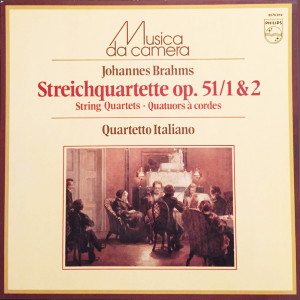 |
|
Philips
- 1 LP - 6570 919
|
|
QUARTETTO ITALIANO
- Paolo Borciani, Elisa Pegreffi, violino
- Piero Farulli,
viola
- Franco Rossi, violoncello |
|
|
|
|
|
Luogo e data
di registrazione |
|
Théatre
Vevey, Vevey
(Svizzera) -
18-31 agosto
1967 (Op. 51
No. 1)
La Salle des
Remparts, La
Tour-de-Peilz
(Svizzera)
- 13-24 giugno
1970 (Op. 51
No. 2)
|
|
|
Registrazione: live
/ studio |
|
studio |
|
|
Producer / Engineer |
|
Vittorio Negri |
Tony
Buczynski |
|
|
Edizione LP |
|
Philips | 6570
919 | 1
LP |
|
|
Prima Edizione CD |
|
Vedi link alla prima
edizione in long playing.
|
|
|
Note |
|
La
collana
"Musica da
Camera" della
Philips
riedita negli
anni
'80
alcune
registrazioni
del Quartetto
Italiano. |
|
|
|
|
Brahms
left only
three string
quartets and
delayed
publication of
the first
until 1873
when he was 40
years old. But
if he was
afraid of his
works being
compared with
Beethoven's,
he was not
afraid of the
shadow of
Beethoven
itself - the
Op. 51
quartets
constantly
acknowledge
Beethoven
openly and
frankly. Nor
was he afraid
of tackling
string-quartet
writing. We
know from his
correspondence
that he wrote
about 20 other
string
quartets
before the C
minor of Op.
51 - none of
which passed
his rigorous
self-set
standards,
though many
must surely
have been
masterpieces.
The Op. 51
quartets,
therefore, are
not the first
he wrote but
rather the
first he chose
to let
posterity
hear. Not that
he was ever
completely
satisfied with
them even
after many
years of
shaping and
polishing.
When he began
work on the C
minor quartet
is not
certain, but
it may have
been as early
as 1865 when
the violinist
Joseph Joachim
wrote to him
to ask if a C
minor quartet
with wich he
was occupied
was not yet
finished for
performance.
Brahm's
publisher
Simrock was
also anxious
for some
quartets and
in June 1869
Brahms wrote
to him from
Lichtenthal
near
Baden-Baden
begging his
patience and
mentioning a
possible
rehersal. The
same month
Clara Schumann
recorded in
her diary that
she had heard
two "lovely"
quartet
movements by
Brahms, one of
which was not
quite to her
taste. Whether
Brahms was
influenced
more by what
he heard in
rehearsal or
by Clara's
opinion is not
clear, but the
Op. 51
quartets in
any event were
held back for
further
amendment. Not
until 1873 and
two further
try-outs did
the composer
put the two
works
resignedly in
Simrock's
hands.
Both
were dedicated
to his friend
Dr. Theodor
Billroth, a
Viennese
surgeon and
talented
string-player.
Yet it seems
odd that the
dedication, of
one at least,
should not
have been to
his closer
friend
Joachim,
particularly
when the
second quartet
employs
thematically
the musical
mottoes the
two used at
the height of
their
friendship -
Joachim's F A
E representing
"Frei Aber
Einsam" (Free
but lonely)
and Brahm's F
A F, "Frei
Aber Froh"
(Free but
happy). This
minor mystery
is deepened by
the fact that
Brahms wrote
to Billroth
revealing the
intention to
dedicate one
of the Op. 51
quartets to
him. Brahm's
biographer
Kalbeck formed
the not
unlikely
theory that
the composer
withheld the
Joachim
dedication in
a fit of
ill-temper.
The
opening
movements of
both quartets
are
characteristically
built from the
smallest of
thematic
bricks. In the
C minor's
sombre, almost
tragic first
movement
significant
motifs are
combined to
form short
subject
groups. What
might have
been a similar
tragic
atmosphere in
the A minor's
first movement
is dispelled
by a more
traditionally
lyrical second
subject. But
the immense
power remains,
lent by the
terseness of
the main
theme which
opens with
Joachim's F A
E motto
(eventually
fused with
Brahm's F A F
in the coda.)
Both
slow
movements,
though rich
and
imaginative,
are based on
simple ABA
structures.
The
melancholic
"Romanze" of
No. 1 has two
distinct
themes, the
second
inescapably
recalling the
Cavatina of
Beethoven's
Op. 130.
The
scherzos, both
in minor keys,
do little to
provide light
relief and
they serve to
lend impetus
to the short
finales, which
sum up their
respective
works both
emotionally
and
thematically.
A.
David Hogarth
|
| Illustration:
Johann Carl Arnold (1829-1916)
"Quartettabend bei Bettina von
Arnim", um 1855, detail (Freies
Deutsches Hochstift, Frankfurt
am Main) |
|